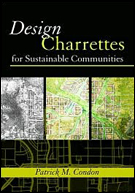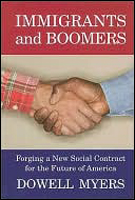Planetizen is pleased to release its seventh annual list of the ten best books in the planning field. With titles covering some of the most timely issues in planning -- from sustainability planning to the changing demographics that are shaping cities and countries -- the list gives readers an overview of the best ideas and writing in the field.
Planetizen Top 10 Books List, 2008 Edition
Planetizen is pleased to release its seventh annual list of the ten best books in the planning field. With titles covering some of the most timely issues in planning -- from sustainability planning to the changing demographics that are shaping cities and countries -- the list gives readers an overview of the best ideas and writing in the field. The Planetizen editorial staff based its 2008 edition list on a number of criteria, including editorial reviews, sales rankings, popularity, Planetizen reader nominations, number of references, recommendations from experts and the book's potential impact on the urban planning, development and design professions. Planetizen welcomes review copies of books published in 2008 for consideration for next year's Top 10 Books List, or for longer book reviews in the Planetizen Features section. Below are summaries for each selected title, in alphabetical order.
 Design Charrettes for Sustainable Communities by Patrick M. Condon
Design Charrettes for Sustainable Communities by Patrick M. Condon
Island Press, 192 pages
The design charrette has gained popularity and notoriety among many communities as a powerful tool for public participation in recent years, and this book provides a step-by-step manual to harness this power. Drawing on Condon's years of experience shaping and honing the charrette process, this book is a straightforward guide that lays out the essential steps and best practices for running a productive design charrette. His advice is equally applicable to public officials, developers and the general public – offering an insider's view into the somewhat complicated process of pushing plans forward with both transparency and an ear to the public voice.
 Immigrants and Boomers: Forging a New Social Contract for the Future of America by Dowell Myers
Immigrants and Boomers: Forging a New Social Contract for the Future of America by Dowell Myers
Russell Sage Foundation Publications, 356 pages
A detailed examination of the probable future impact of two of the nation's biggest demographic groups. Myers uses extensive demographic data to explain the likely effect of the aging and soon-retiring Baby Boomer population on the economy and nationwide workforce, and argues that the coming void can be filled by the nation's rapidly growing immigrant population. His book provides a framework for preparing this population to compensate for the Baby Boom's departure from the workforce – a strategy that will rely on expanded education and better integration of immigrants into the job market and tax system, as well as their inclusion among the ranks of American homeowners.
 Last Harvest: How a Cornfield Became New Daleville by Witold Rybczynski
Last Harvest: How a Cornfield Became New Daleville by Witold Rybczynski
Scribner, 320 pages
An in-depth account of a neotraditional housing subdivision in exurban Pennsylvania that follows the project from idea to first resident. Last Harvest documents the entire development process and all the bumps and bruises experienced along the way, providing a frank and detailed profile of what it's like to build a project that breaks from the status quo and that attempts to stay afloat in a cooling market.
 Smart Growth in a Changing World by Jonathan Barnett, F. Kaid Benfield, Paul Farmer, Shelley Poticha, Robert Yaro and Armando Carbonell
Smart Growth in a Changing World by Jonathan Barnett, F. Kaid Benfield, Paul Farmer, Shelley Poticha, Robert Yaro and Armando Carbonell
University of Chicago Press, 148 pages
This book features a collection of works by noted experts in smart growth, and examines how standard American consumption and wasteful land use are steadily compounding threats to our environment, health and way of life. The book features case studies from throughout the country and provides a look at the national policies that either encourage or limit smart growth development patterns. And as the U.S. population is expected to climb to more than 400 million within the next 30 years, the authors argue that updating American land use habits will be critical to sustain the country's growth and maintain its global competitiveness.
 Sustainable Design: Ecology, Architecture, and Planning by Daniel E. Williams, David W. Orr and Donald Watson
Sustainable Design: Ecology, Architecture, and Planning by Daniel E. Williams, David W. Orr and Donald Watson
Wiley, 304 pages
This introductory book offers an architectural perspective on the increasing trend towards environmentally friendly development. Williams, a noted architect and planner, looks at the applicability of sustainable design at all scales – from the region to the community to the building. He also delves into the differences between a design that is simply green and a design that is sustainable, emphasizing the importance of a systems-approach based on ecology. The major outcome of this book is a well-reasoned argument for a drastic renovation of the way design is taught, considered and performed.
 Sustainable Urbanism: Urban Design With Nature by Douglas Farr
Sustainable Urbanism: Urban Design With Nature by Douglas Farr
Wiley, 256 pages
A broadly-focused and solutions-based look at environmentally sustainable urban design. This heavily illustrated guide calls on planners, architects and designers to reframe their work to do the double-duty of creating great places while reducing the human impact on the environment. Case studies and essays written by Farr and others give a real-world context to the ideas and methods espoused in this ambitious argument on behalf of a new type urban design and development that is interrelated with nature.
 The Best-Laid Plans: How Government Planning Harms Your Quality of Life, Your Pocketbook, and Your Future by Randal O'Toole
The Best-Laid Plans: How Government Planning Harms Your Quality of Life, Your Pocketbook, and Your Future by Randal O'Toole
Cato Institute, 416 pages
In example after example, O'Toole shows government planning at its worst. His detailed argument is that this poor track record proves government planning should not be trusted to manage the future of our communities. This book will bolster the outlook of like-minded libertarians and other hands-off types, but is also a good read for pro-planning planners. It presents the contrarian's view that many planners may encounter in their careers, plainly illustrating the mindframe of "the other side". And though the book provides a lot of examples and unfortunate failures, few alternatives and solutions are provided.
 The Great Neighborhood Book: A Do-It-Yourself Guide to Placemaking by Jay Walljasper
The Great Neighborhood Book: A Do-It-Yourself Guide to Placemaking by Jay Walljasper
New Society Publishers, 173 pages
The power to create great places doesn't just belong in the hands of a few designers and planners, according to this mobilizing book from Jay Walljasper. He shows how citizens can get involved and push for the traits that can bring that "there" factor to any place or neighborhood. By using real-world examples and introducing individuals who have gone beyond the bureaucracy to create positive change, this book shows that placemaking really can be a power of the people.
 The Option of Urbanism: Investing in a New American Dream by Christopher B. Leinberger Island Press, 224 pages The new American Dream presented in this quick and easy read is one similar to the American Dream of the past: a slower-paced and neighborhood-centric lifestyle. Leinberger call this walkable urbanism, and he uses history and economic analysis to show how market preference is shifting back towards this development pattern and away from the drivable suburbanism that monopolized the last 60 years.
The Option of Urbanism: Investing in a New American Dream by Christopher B. Leinberger Island Press, 224 pages The new American Dream presented in this quick and easy read is one similar to the American Dream of the past: a slower-paced and neighborhood-centric lifestyle. Leinberger call this walkable urbanism, and he uses history and economic analysis to show how market preference is shifting back towards this development pattern and away from the drivable suburbanism that monopolized the last 60 years.
 Visualizing Density by Julie Campoli and Alex S. MacLean
Visualizing Density by Julie Campoli and Alex S. MacLean
Lincoln Institute of Land Policy, 152 pages
This vivid and visual book is one of the essential guides to understanding the concept of density. It provides aerial photos and street pattern maps for the entire range of housing density in America – from 0.2 units per acre in Beverly Hills to nearly 300 units per acre in New York City. In this book version of the 2007 Planetizen Top Website "Visualizing Density", Campoli presents accurate descriptions of density and land use patterns in the United States, and offers the stepping stones to planning and designing for a society of greater density. MacLean's beautiful and varied aerial photography gives an impressive view of hundreds of parts of the country and, at the same time, a disturbing look at the wasteful development pattern that has persevered in the U.S. for decades.
Other Noteworthy Titles
 Boomburbs: The Rise of America's Accidental Cities by Robert E. Lang and Jennifer B. LeFurgy
Boomburbs: The Rise of America's Accidental Cities by Robert E. Lang and Jennifer B. LeFurgy
Brookings Institution Press, 212 pages
This interesting book provides an overview of the "accidental cities" that have formed as suburbs suddenly experience huge population growth. The authors examine how these cities are trying to form themselves into coherent units from the multitude of disparate parts that had not intended on uniting. In examining this new type of city, Boomburbs brings the conclusion that these overgrown suburbs are on track to become the new dominant metropolitan form in the United States.
 Regenerating Older Suburbs by Richard B. Peiser
Regenerating Older Suburbs by Richard B. Peiser
Urban Land Institute, 217 pages
A solutions-based examination of aging suburbs that uses case studies to outline the history and future of these significant and popular areas. By looking at 10 different inner-ring suburbs, this book presents the gamut of developmental stages. Each community's attempts to revitalize itself offers examples of successful strategies that have helped bring about or attract broad redevelopment projects.
 Site Analysis: A Contextual Approach to Sustainable Land Planning and Site Design (2nd Edition) by James A. LaGro Jr.
Site Analysis: A Contextual Approach to Sustainable Land Planning and Site Design (2nd Edition) by James A. LaGro Jr.
Wiley, 384 pages
A step-by-step guide that presents detailed instructions on how to perform a careful and comprehensive analysis of development sites. This second edition book features more than 100 illustrations, maps and site plans of actual projects, giving readers a look at the end-result of good site analysis. By clearly documenting each of the phases of site planning and design, this book is a useful reference for all planners and developers.
Placer County
City of Morganton
HUD's Office of Policy Development and Research
Dongguan Binhaiwan Bay Area Management Committee
City of Waukesha, WI
Los Angeles County Metropolitan Transportation Authority
Indiana Borough
Urban Design for Planners 1: Software Tools
This six-course series explores essential urban design concepts using open source software and equips planners with the tools they need to participate fully in the urban design process.
Planning for Universal Design
Learn the tools for implementing Universal Design in planning regulations.
